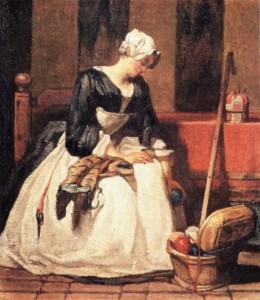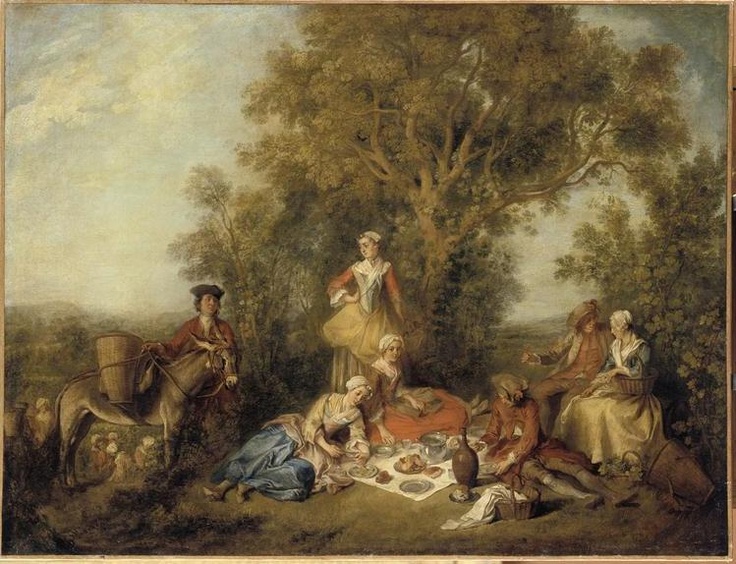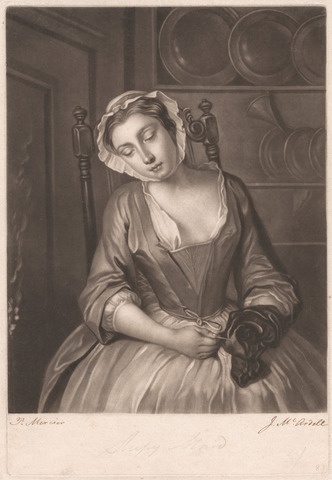Whalebone Stays: Who Wore them? Part 4
(First Half)
Evidence of Plebeian Women Wearing Stays:
This has been the most fascinating of all categories – I did squeak a few times when finding some of these images. Now obviously there are some ground rules to explain. In the 1790’s Sir frederick Eden produced a report entitled ‘The State of the Poor’, within this report (and featuring on page 222 of ‘The Dress of the People’ by John Styles) Eden makes a comment that a cheap pair of stays should last 6 years. We have no definition as to what he meant by a ‘cheap pair of stays’. On page 220 of the same book John Styles states that ‘cloaks and leather stays…were standard features of working women’s wardrobes’. As we have already seen in this post that leather stays could be fully boned (see the Killerton Stays above) but as far as I am aware, leather stays could also be un-boned, relying on the qualities of leather for the support. I have no evidence for this except it is a common conception. This is important because some of the images here, although to my eye look exactly like a pair of fully boned, brown stays, might infact be 1) leather stays cut to the same shape or 2) a ‘cheap pair of stays’ that could be made using cheaper materials or cheaper techniques – we don’t know. With such indefinition what’s the point in going on? Well, in chapter 14 of ‘The Dress of the People’ John Styles concentrates on the family accounts of a poor and low wage farming family whose wages matched the ‘labouring poor’ that Eden set his report on. This means that we know that not only are they classed as ‘plebeian’ but that they are at the lower waged end of the ‘plebeian’ class. Now these family accounts (The family is called the ‘Latham’s’) range from 1724 right through to 1754 and covers both the periods of the Lathan’s having children (their poorest stage), to where some of the children had grown up and were therefore able to bring a wage in to the home and where the mother was now more freed up to work (this is their wealthiest stage). Even in their wealthiest stage their income is still considerably low. All four of the older daughters (whose years are covered in this period) have ‘between one and three pairs of expensive whalebone stays’ (John Styles p.236). The mother too acquired a pair of ‘whalebone stays’. John Styles also thinks it likely that these stays could have been passed down to the younger daughters. In another case, six of a manufacturer’s servants (a one Mr Heaton) bought ‘new’ whalebone stays which John Styles explains as: ‘Stays, though fundamental to the eighteenth century wardrobe and fashionable silhouette, were extremely expensive when made from whalebone and acquired new. Those described as ‘new’ in Heaton’s accounts cost between 16 shillings and 24 shillings’. From Workhouse accounts there is evidence of women having arrived destitute but with ‘Stays’ in their possession and there are cases of Workhouses clothing their inmates with ‘Stays’. Alice Godfrey is a shining example of this, in Cheshire she was supplied with a pair of stays by the workhouse there. Stays didn’t seem to have to be ‘made to measure’ or ‘brand new’ – in the Latham family’s accounts they also register buying from a Tailors atleast one pair of second hand stays. And eight of Heaton’s (the manufacturer again) servants bought second hand stays. The point is, that whether the Stays were bought brand new or second hand, these are clear examples of plebeian women purchasing and wearing whalebone stays.
On page 220 of the same book John Styles states that ‘cloaks and leather stays…were standard features of working women’s wardrobes’. As we have already seen in this post that leather stays could be fully boned (see the Killerton Stays above) but as far as I am aware, leather stays could also be un-boned, relying on the qualities of leather for the support. I have no evidence for this except it is a common conception. This is important because some of the images here, although to my eye look exactly like a pair of fully boned, brown stays, might infact be 1) leather stays cut to the same shape or 2) a ‘cheap pair of stays’ that could be made using cheaper materials or cheaper techniques – we don’t know. With such indefinition what’s the point in going on? Well, in chapter 14 of ‘The Dress of the People’ John Styles concentrates on the family accounts of a poor and low wage farming family whose wages matched the ‘labouring poor’ that Eden set his report on. This means that we know that not only are they classed as ‘plebeian’ but that they are at the lower waged end of the ‘plebeian’ class. Now these family accounts (The family is called the ‘Latham’s’) range from 1724 right through to 1754 and covers both the periods of the Lathan’s having children (their poorest stage), to where some of the children had grown up and were therefore able to bring a wage in to the home and where the mother was now more freed up to work (this is their wealthiest stage). Even in their wealthiest stage their income is still considerably low. All four of the older daughters (whose years are covered in this period) have ‘between one and three pairs of expensive whalebone stays’ (John Styles p.236). The mother too acquired a pair of ‘whalebone stays’. John Styles also thinks it likely that these stays could have been passed down to the younger daughters. In another case, six of a manufacturer’s servants (a one Mr Heaton) bought ‘new’ whalebone stays which John Styles explains as: ‘Stays, though fundamental to the eighteenth century wardrobe and fashionable silhouette, were extremely expensive when made from whalebone and acquired new. Those described as ‘new’ in Heaton’s accounts cost between 16 shillings and 24 shillings’. From Workhouse accounts there is evidence of women having arrived destitute but with ‘Stays’ in their possession and there are cases of Workhouses clothing their inmates with ‘Stays’. Alice Godfrey is a shining example of this, in Cheshire she was supplied with a pair of stays by the workhouse there. Stays didn’t seem to have to be ‘made to measure’ or ‘brand new’ – in the Latham family’s accounts they also register buying from a Tailors atleast one pair of second hand stays. And eight of Heaton’s (the manufacturer again) servants bought second hand stays. The point is, that whether the Stays were bought brand new or second hand, these are clear examples of plebeian women purchasing and wearing whalebone stays.  The images for this section all include what we consider pretty clear examples of boned stays – although we do concede that, especially with the lack of the definition of ‘Cheap stays’ (Eden in the 1790’s) it’s hard to be conclusive. – The first image is entitled ‘the Embroideress’ and is by Chardin (no exact date).
The images for this section all include what we consider pretty clear examples of boned stays – although we do concede that, especially with the lack of the definition of ‘Cheap stays’ (Eden in the 1790’s) it’s hard to be conclusive. – The first image is entitled ‘the Embroideress’ and is by Chardin (no exact date).  From her clothes and the surrounding furniture we can glean that she is not the poorest of working women but she is still a good example of a working woman wearing a pair of stays. She has such a swelling above her bust line, such a forced in cone-like shape that it seems pretty obvious that she is wearing a pair of boned stays. She also sports a really long and full working apron and is wearing what looks likes a Robe a l’Anglais. – The next image is another Paul Sandby sketch (see a little bit above) and although it is a basic drawing there are several things that suggest that she is wearing a pair of stays. She has a controlled look about her torso, she has the low decolletage and low shift neckline as well, which suggest a pair of stays, as they tended to be cut very low. She has the pushed up bust and there is no centre front opening to her top which would suggest a pair of bodies. She, like some of the other plebeian images above is wearing her apron tucked into the band and a basic skirt. She looks fairly well ‘bustled’ as well, her skirts looking like she is either wearing a few layers to create the effect or actual hip-pads or a quilted petticoat which we’re unable to see. – The next image to that, is the one on the right and is entitled ‘Black Heart Cherries’, also by Paul Sandby, and featuring in the ‘Cries of London’ series, 1759. This is quite an intriguing sketch. For starters, her torso when looked at as a whole (even though her arm cuts across it) is a definite cone shape and very rigid in form. Her bust is also up and she isn’t ‘waisted’ in the sense of having that natural curvature to the waist one would expect on a non-stayed shape. Just for interest she also has a striped skirt and, what’s most exciting to us, is having an actual drawing that shows a lady wearing her pockets. Even though it’s in watercolour and therefore quite vague, you can still see her large-ish pockets (plain and much bigger than the embroidered ones you find in the museums) appearing from under her pulled up skirts. These pulled up skirts are another satisfying fact. I love the way Paul Sandby has even managed to get that accurate look of a thin dress and the way that linen looks when it’s dragged up. Brooke mentions in her book that skirts were starting to be tucked up right from the late 40’s and it’s lovely to see an example of what this looked like. It’s so easy to get this look confused with the Polonaise style that hit England a few years later.
From her clothes and the surrounding furniture we can glean that she is not the poorest of working women but she is still a good example of a working woman wearing a pair of stays. She has such a swelling above her bust line, such a forced in cone-like shape that it seems pretty obvious that she is wearing a pair of boned stays. She also sports a really long and full working apron and is wearing what looks likes a Robe a l’Anglais. – The next image is another Paul Sandby sketch (see a little bit above) and although it is a basic drawing there are several things that suggest that she is wearing a pair of stays. She has a controlled look about her torso, she has the low decolletage and low shift neckline as well, which suggest a pair of stays, as they tended to be cut very low. She has the pushed up bust and there is no centre front opening to her top which would suggest a pair of bodies. She, like some of the other plebeian images above is wearing her apron tucked into the band and a basic skirt. She looks fairly well ‘bustled’ as well, her skirts looking like she is either wearing a few layers to create the effect or actual hip-pads or a quilted petticoat which we’re unable to see. – The next image to that, is the one on the right and is entitled ‘Black Heart Cherries’, also by Paul Sandby, and featuring in the ‘Cries of London’ series, 1759. This is quite an intriguing sketch. For starters, her torso when looked at as a whole (even though her arm cuts across it) is a definite cone shape and very rigid in form. Her bust is also up and she isn’t ‘waisted’ in the sense of having that natural curvature to the waist one would expect on a non-stayed shape. Just for interest she also has a striped skirt and, what’s most exciting to us, is having an actual drawing that shows a lady wearing her pockets. Even though it’s in watercolour and therefore quite vague, you can still see her large-ish pockets (plain and much bigger than the embroidered ones you find in the museums) appearing from under her pulled up skirts. These pulled up skirts are another satisfying fact. I love the way Paul Sandby has even managed to get that accurate look of a thin dress and the way that linen looks when it’s dragged up. Brooke mentions in her book that skirts were starting to be tucked up right from the late 40’s and it’s lovely to see an example of what this looked like. It’s so easy to get this look confused with the Polonaise style that hit England a few years later. – The large image is a painting by Lancret that was one in a collection of Four and based on the ‘Season’s’. It was painted in 1738. This is Autumn pictured here and atleast three of the ladies seem to have silhouettes that would suggest stays. Although there’s no definite hint to the wealth of the sitters (the other important factor to making this image useful), there are certain keys we can use to guess their slightly lower statuses. First, all of their clothing are simple basic colours and lack any of the fresher colours and patterns that were coming in. The centre front lady is the only one who appears to have a fashionable colour with her blue satin-looking skirt but it is an interesting mix. She wears an apron that has a bib front which suggests a working apron (Cunnington’s ’64) and no dress, which would be more expected if she was of a wealthier class. The yellow-ish/beige-ish sleeves seem to suggest a bedgown as no skirt can be seen ruffled about the ground around her. The other women all join her in a skirt and bedgown/coat except the lady standing up who seems to be in a pair of stays. If you look closely at her, the bodice part of her dress has such a controlled and pointed and shaped look about it – exactly like a pair of mid-century stays; broad and very high. Now, according to this painting, she is also wearing a pair of sleeves with these Stays. Sleeves were worn with stays but is a fashion that came in from the previous century. It’s funny how some images create more questions than they answer! She also seems to wear her apron tucked up in the same way the other plebeian women in the above section had worn theirs. The only man whose stockings we can see, sports a dark pair which speaks highly of plebeian status. Him and all the other men are dressed in very plain breeches and coats, in various shades of brown. They also have a donkey in their midst which I would have thought was quite an un-posh thing to do, and although they are having a picnic which in our minds seems like quite genteel thing to do, it was a past-time that social writers of the day either commended or criticized the workers for doing. Wow this is wordy!
– The large image is a painting by Lancret that was one in a collection of Four and based on the ‘Season’s’. It was painted in 1738. This is Autumn pictured here and atleast three of the ladies seem to have silhouettes that would suggest stays. Although there’s no definite hint to the wealth of the sitters (the other important factor to making this image useful), there are certain keys we can use to guess their slightly lower statuses. First, all of their clothing are simple basic colours and lack any of the fresher colours and patterns that were coming in. The centre front lady is the only one who appears to have a fashionable colour with her blue satin-looking skirt but it is an interesting mix. She wears an apron that has a bib front which suggests a working apron (Cunnington’s ’64) and no dress, which would be more expected if she was of a wealthier class. The yellow-ish/beige-ish sleeves seem to suggest a bedgown as no skirt can be seen ruffled about the ground around her. The other women all join her in a skirt and bedgown/coat except the lady standing up who seems to be in a pair of stays. If you look closely at her, the bodice part of her dress has such a controlled and pointed and shaped look about it – exactly like a pair of mid-century stays; broad and very high. Now, according to this painting, she is also wearing a pair of sleeves with these Stays. Sleeves were worn with stays but is a fashion that came in from the previous century. It’s funny how some images create more questions than they answer! She also seems to wear her apron tucked up in the same way the other plebeian women in the above section had worn theirs. The only man whose stockings we can see, sports a dark pair which speaks highly of plebeian status. Him and all the other men are dressed in very plain breeches and coats, in various shades of brown. They also have a donkey in their midst which I would have thought was quite an un-posh thing to do, and although they are having a picnic which in our minds seems like quite genteel thing to do, it was a past-time that social writers of the day either commended or criticized the workers for doing. Wow this is wordy!



